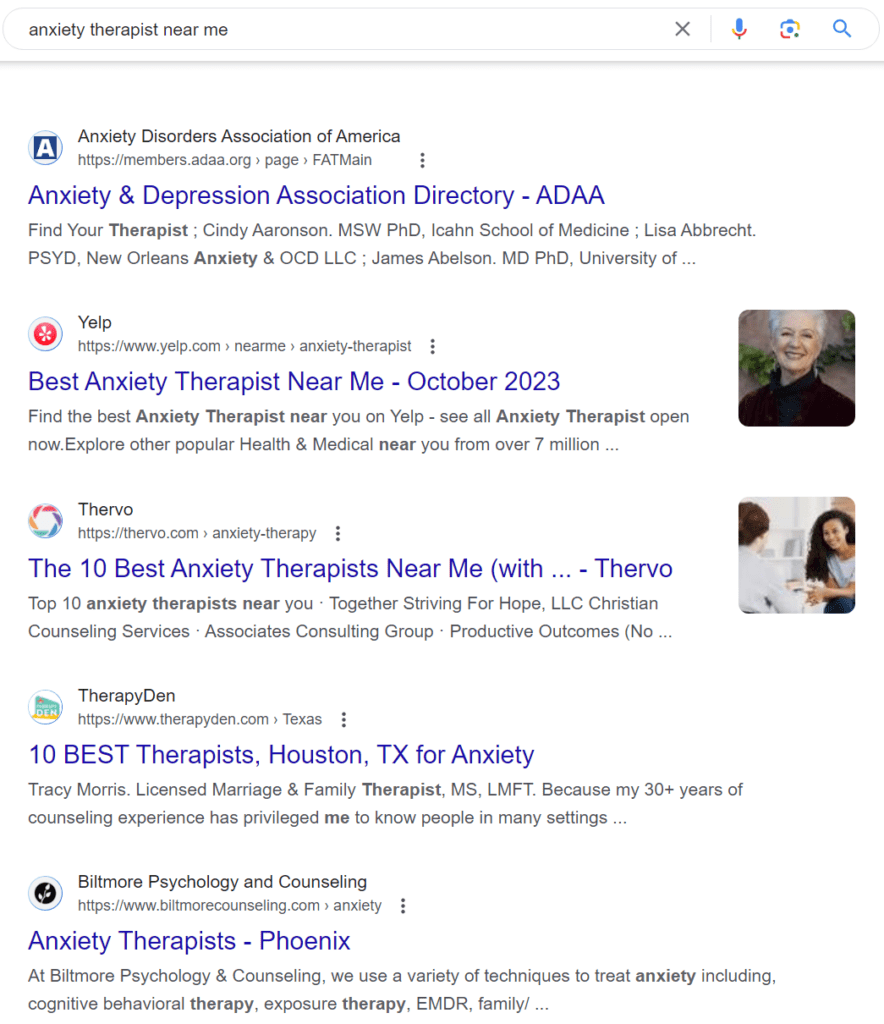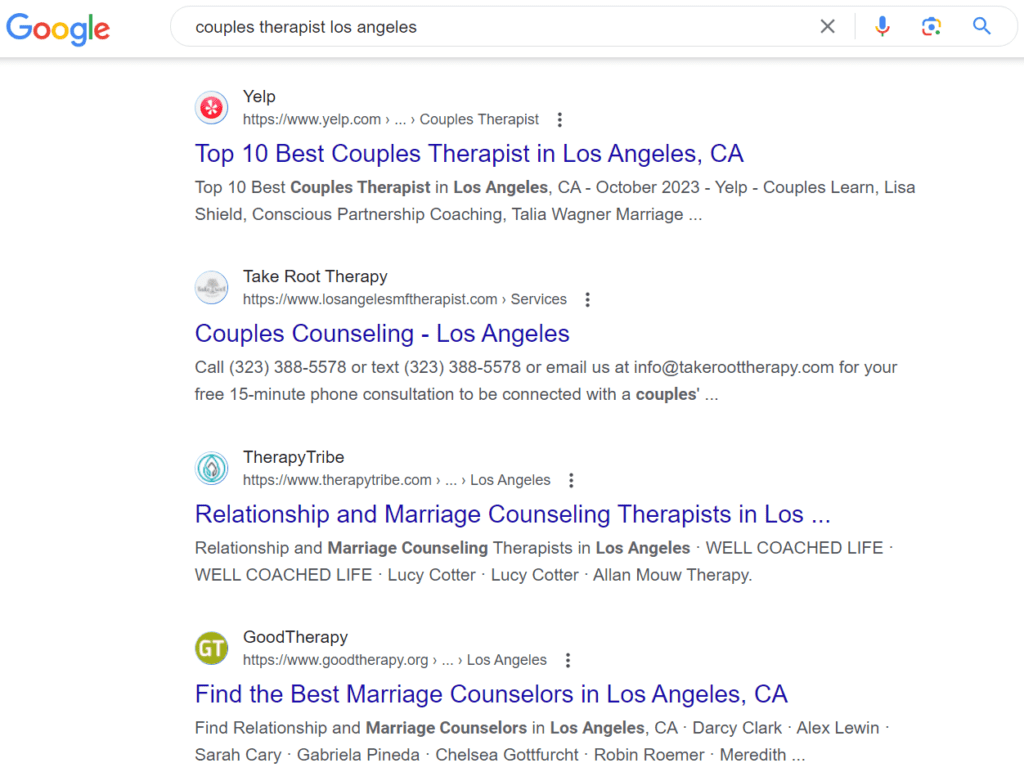How to Attract More Clients as a Therapist: A Simple & Actionable Guide

Introduction to Therapist Client Acquisition
In the realm of therapy, acquiring new clients is the lifeblood that fuels the growth of your practice.
In years past, a referral-based approach with other professionals and even by evangelizing patients themselves was the norm.
However, the digital age has numerous new platforms and strategies that therapists can leverage to expand their clientele. Entire practices are being built using only the power of the internet to reach people who are looking for help.
This means that understanding and embracing modern marketing strategies has become indispensable for therapists aiming to build a healthy practice.
This guide delves into proven tactics to broaden and deepen your new client acquisition playbook.
Before We Begin: What Are Your Goals?
Your goals may vary depending on who you are and the type of practice you run. For a single therapist looking to build their private practice business, some common goals include reaching a certain capacity of weekly appointments or increasing the percentage of a certain kind of client they prefer to see.
For larger practices, goals might include keeping multiple clinicians at a full caseload, expanding types of programming such as group therapy or workshops, and growing a brand to add locations.
No matter which category of therapist you fall into, it’s helpful to get clear about what you would like to achieve in your practice over the next several months to a year in order to prioritize the steps you’ll take.
Section 1: Understanding Your Niche and Ideal Client
A crucial step towards expanding your clientele involves defining your niche and understanding your ideal client. In a saturated market, specializing in a particular area sets you apart, making you a go-to therapist for specific issues.
“Therapists are being eclipsed by coaches for one simple reason –
-Marc Azoulay LPC, LAC, ACS, CGP
mis-attuned marketing. In the digital world, the process of building
rapport starts with our marketing messaging. It is on us to speak to our
client’s needs, hopes, and fears so that they can take that life
changing step of asking for help.”
Founder of Men’s Therapy Online
Identifying Your Niche
The first stride in niche marketing involves identifying a sector of therapy that resonates with your expertise and passion. Whether it’s couples counseling, cognitive-behavioral therapy, or dealing with anxiety disorders, honing in on a specific niche helps in refining your marketing message. Here are some questions to consider:
- Is there a particular modality I specialize in?
- What conditions to I like to help with?
- What audiences have been most meaningful?
Ultimately, defining your niche positions you as an expert in a particular field, making it more likely for individuals seeking specialized help to turn to you and differentiating you from your competitors.
Create an Avatar For Your Ideal Client
Understanding your ideal client is pivotal so that you can be intentional about attracting more people with similar characteristics to your practice and ultimately do the most good.
Create a fictional, detailed profile of your ideal clients that encompass demographics, behavioral patterns, and the specific issues they are facing.
For instance, an avatar might be based on a young professional struggling with work-life balance, with a certain level type of job, relationship status, homeownership, or belief system.
You can start by thinking about your current clients and listing down different attributes about them, and then looking for features that overlap.
One question that can be a north star: Who have I been able to help the most?
Even taking 10 minutes to write down these features and then distilling them into a basic avatar will benefit your marketing strategy, ensuring they resonate with the individuals you aim to serve.
Create Brand Messaging Based On Your Avatar
Your marketing message should clearly articulate the problems you solve and the outcomes clients can expect. It’s not just about listing the services you offer, but highlighting how you can transform the lives of your clients.
Based on your newly created avatar, attempt to write some taglines that answer “what’s in it for me?”
It might be helpful at first to use a framework while you brainstorm, which could look like:
“Helping {Avatar} to {Achieve Desired Outcome} even if {Usual objection or challenge}”
Some real-life examples could look like:
- Helping young professionals achieve work life balance even if they have a high-stress career
- Helping couples find common ground even if they argue about finances
- Helping moms learn to overcome anxiety even if they’ve tried therapy before
Branching off of this, you can start to build more core messages related to how you do what you do and who you are. Things such as:
- Coaching clients on skills based on cognitive behavioral therapy
- Facilitating group therapy to raise self-awareness
- 9 years of experience treating PTSD using EMDR
Utilize client testimonials, before-after scenarios, and relatable stories to make your message more compelling and relatable.
These are messages that will appear in places where prospective patients find you, and they can also aid with in-person discussion and the “elevator pitch”, so time invested in developing them is well-spent.
Section 2: Optimize Your Online Presence
Your online presence is often the initial touchpoint potential clients have with your practice. A well-curated online presence not only reflects your professionalism but also significantly impacts client acquisition. Here’s how to optimize your online presence:

Optimize Your Website
Create a professional website that clearly articulates your services, specialties, and the benefits clients can expect. Integrate the brand messaging you developed earlier to help set you apart, and feature high quality visuals of yourself, your place of practice, and supporting imagery.
Ensure your website is user-friendly, with easy navigation, clear call-to-actions, and a responsive design that adapts to various screen sizes.
If possible, create some simple videos walking through your practice, your avatar, and a call-to-action (perhaps a free initial consultation).
Search Engine Optimization (SEO)
SEO is your gateway to being discovered online by potential clients because it ensures your website ranks higher on search engine results.
It can sound mystical, but it’s really not. Here’s how to do it:
- Sign up for Google Search Console (a free tool Google provides to website owners) to ensure there is nothing preventing a search engine from finding and understanding your website
- Install Google Analytics 4 (another free tool) on your website to start collecting data for later review
- Perform keyword research with a tool like the SEMRush (click the link and sign up for free) “Keyword Magic Tool“
- Update the page titles and headings for the homepage and main service pages on your website
- Enrich your other website content with additional information on the topic
Keep in mind that a suitable page title for the homepage of a single therapist might look like:
Couples Counseling Therapist New York City | Sally Jones
After you take some of these basic steps designed to lay the foundation for SEO on your website, turn your attention to the highest priority “off page SEO” items.
Off-Page SEO Item One: Google Business Profile
If you don’t already have one, Google Business Profile is arguably the #1 most important online marketing tool for your therapy practice after your website. In some cases, it may be even more valuable because of how often Google shows these results for searches that contain locations or “near me” in them.
Navigate to the website for this free tool to claim your listing. Be sure to add your Name, Address, and Phone number and that those details match your website.
The more information you can add to your GBP, the better. This includes interior & exterior photos of your office, a link to your website, your hours of operation, and importantly your Business Category and Services offered.
If you’re ready to take additional steps, you can even integrate your online booking tool, turn on messaging, and post regular updates sharing what’s new in your practice and other helpful information.
GBP is also where reviews of your practice will get centralized from Google’s perspective, so don’t neglect it.
Off-Page SEO Item Two: Directory Listings
List your practice on reputable therapist directories, providing comprehensive and engaging profiles to attract potential clients.
Sometimes these listings are referred to as “citations”, which simply means links to your website that include your Name, Address and Phone.
It almost goes without saying that you’ll want to at a minimum claim your free profile on Psychology Today.
But an easy way to find other valuable directories to appear on is to Google search some of the important keywords related to your practice, and then take note of the URLs in the top 10 results.
Similarly to the example below, you might find associations, industry listing pages, and even common consumer websites like Yelp.com appearing highly.

Social Media Engagement
Establish a presence on social media platforms relevant to your target audience. Share thought leadership on your areas of expertise, insightful content from other therapists and publishers, engage in discussions around common questions you receive, and connect with individuals who resonate with your practice’s mission.
To take your social media presence to the next level, you can explore short-form video such as with YouTube Shorts, Instagram Reels or TikTok posts to hit on popular topics in your niche.
These formats tend to have higher levels of reach than ordinary organic posts on social platforms and with a well-optimized profile you can drive traffic back to your booking link or practice website.

Online Reviews and Testimonials
Encourage satisfied clients to leave positive reviews on platforms like Google Business Profile (formerly called “Google My Business”). Showcase these testimonials on your website and social media channels to build trust with prospective clients.
A solid base of reviews and ratings is an asset in building a thriving therapy practice, enabling you to connect with, engage, and attract more clients effectively.
Make sure that you review the search engine results pages for your geography and area of practice to determine which websites might be most helpful to collect reviews on. If they appear on the first page, add them to the consideration list.
It’s not uncommon to see many of the following appear highly in search results for various kinds of therapy practices:
- Psychology Today
- Betterhelp
- Thumbtack
- Yelp
- The Gottmann Institute

Content Marketing
Content marketing is about sharing your knowledge in a helpful, accessible way. It’s extending a hand of support before a client steps into your office.
One of the easiest ways to start is by creating a blog and writing posts addressing common concerns or share success stories (anonymized, with consent).
As you begin to build a body of work on your blog, you can extend this strategy by guest posting on reputable platforms, offering a gentle introduction to your approach and services.
Be sure to invest the time in responding to comments, showing you’re there to help, even outside the therapy room
Social Media
Social media is a window into your practice, showing the warmth and understanding awaiting within. It’s about creating connections, offering support, and building a community.
You can take a bottom-up approach on social, sharing curated resources, insights, and gentle encouragements that reflect your practice’s ethos.
You could also repurpose existing blog content you’ve already created into short series of posts or iterate on them by providing different perspectives on their topics.
As with your blog, it’s equally important to respond to comments and messages with empathy and understanding, fostering a supportive environment.
Another angle to use social media to your benefit as a therapist is by connecting with other professionals in your area and sharing resources and referrals.
After you have been active for some time on your social media profile, you can consider extending your reach further by running targeted advertising to either boost your organic content or to reach people who might be struggling with an issue that you may be able to help them with.
Email Marketing
Email marketing is a bridge between your expertise and those in need. It can help to acquire new patients by reaching them with helpful content as they are on their journey toward seeking treatment, and it can likewise increase engagement among your current clients.
Build your list by collecting emails through your website, perhaps offering a valuable resource in exchange. Mention your new email newsletter to your current clients and ask if they would be interested in signing up for updates and helpful resources.
Craft your message by sharing stories of transformation, insightful articles, or new resources in a friendly, supportive tone. To make it your own, share personal anecdotes, areas of research and interest, and patterns you’re noticing during different seasons.
Regular, timely emails build a rhythm of trust and anticipation.
Ensure a clear, easy opt-out option is available in every email, respecting the choice of those who’d prefer to step back.
Section 3: Modern Practices
Adopting modern practices not only aligns your therapy services with current trends but also caters to evolving client preferences. Here’s a glimpse into modern practices that can bolster your client base:
Teletherapy

Incorporate teletherapy to extend your services to clients irrespective of geographical boundaries. Offer secure video sessions to cater to the preference for remote counseling.
Flexible Pricing
Introduce sliding-scale fees, making therapy accessible to a wider demographic, fostering inclusivity while expanding your clientele.
Online Scheduling
Implement an online scheduling system for streamlined bookings, providing convenience to both you and your clients. Some tools offer additional functionality for operations, finance, and other business needs, or may allow you to get consent forms signed prior to scheduling.
If your model of practice includes offering a free consultation up-front prior to the first appointment, you could use a tool like Calendly to make scheduling more convenient for both parties.
Once you’ve onboarded a scheduling tool, you can then link to it from both your Google Business Profile and your Facebook Page to encourage online bookings.
Digital Resources
Provide digital resources like e-books or online courses, adding value and showcasing your expertise in your niche.
Embracing modern practices not only enhances your service delivery but also positions your practice to attract a diverse client base.
Section 4: Networking and Referrals

Networking and referrals are timeless strategies to grow your practice. Here’s how to harness them effectively:
Build Relationships
Cultivate relationships with other healthcare professionals. Regular referrals can significantly boost your client base.
Community Engagement
Engage in local community events, offer free workshops, and join professional therapy networks to build a strong local presence.
Online Forums and Groups
Participate in online mental health forums, offering advice and establishing your authority in your niche.
Referral Programs
Consider implementing a referral program, incentivizing current clients to refer others.
Through a combination of networking and leveraging referrals, you can establish a trusted reputation and attract more clients organically.
Parting Advice: Be Responsive
Ultimately, you can generate all of the leads in the world but if you are poor at responding in a timely manner you will not be able to grow your practice.
Tyler Loomis LPC, MA, a couple’s therapist based in Wisconsin, had this to say:
“I hear about a lot of potential clients failing to hear back from therapists that they might be interested in making an appointment with. I try to make it a goal to respond to people within 24 hours after initial contact. Therapists need to be careful about gaining a reputation for being too busy or unavailable or non-responsive.”
-Tyler Loomis LPC, MA
Founder of TGL Wellness Clarity Counseling
Conclusion
In a competitive landscape, growing your therapy practice demands a blend of traditional and digital strategies. By understanding your niche, enhancing your online presence, employing digital marketing, adopting modern practices, and leveraging networking and referrals, you pave a path towards a thriving practice.
This guide provides a roadmap to navigate the multifaceted approach needed to attract more clients. Implement these strategies, measure your progress, and continuously adapt to the evolving market demands to ensure the sustained growth of your practice.
Want more advanced help to grow your therapy practice?
Contact us today to learn about our SEM Agency services.

